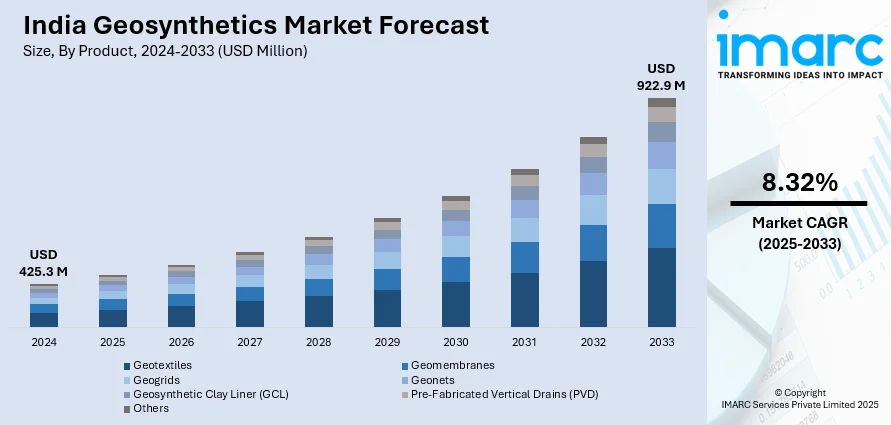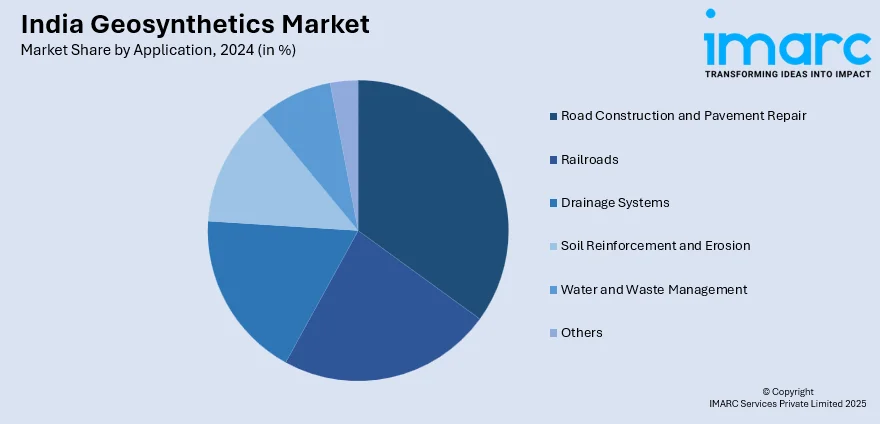
India Geosynthetics Market Size, Share, Trends and Forecast by Product, Type, Material, Application, and Region, 2025-2033
Market Overview:
India geosynthetics market size reached USD 425.3 Million in 2024. Looking forward, IMARC Group expects the market to reach USD 922.9 Million by 2033, exhibiting a growth rate (CAGR) of 8.32% during 2025-2033. The regional trend of urbanization, coupled with population growth, which has led to increased demand for geosynthetics in construction projects, especially in urban areas where space is limited, is driving the market.
|
Report Attribute
|
Key Statistics
|
|---|---|
|
Base Year
|
2024
|
|
Forecast Years
|
2025-2033
|
|
Historical Years
|
2019-2024
|
| Market Size in 2024 | USD 425.3 Million |
| Market Forecast in 2033 | USD 922.9 Million |
| Market Growth Rate 2025-2033 | 8.32% |
Geosynthetics refers to a category of synthetic materials used in geotechnical and civil engineering applications to enhance the performance of soil and rock structures. These materials include geotextiles, geogrids, geomembranes, geocomposites, and geocells. Geosynthetics are employed to improve soil stability, control erosion, reinforce slopes, and provide drainage solutions. Geotextiles, for instance, act as filters and separators, preventing soil erosion and promoting water drainage. Geogrids are used to reinforce soil structures, enhancing their load-bearing capacity. Geomembranes serve as impermeable barriers for containment applications, such as landfill liners. Geosynthetics contribute to sustainable construction practices by reducing environmental impact, enhancing infrastructure durability, and providing cost-effective solutions. Their versatility makes them integral in addressing various geotechnical challenges, promoting efficient and resilient engineering solutions.

To get more information on this market, Request Sample
India Geosynthetics Market Trends:
The geosynthetics market in India is witnessing a surge in demand, primarily driven by the escalating infrastructure development and environmental concerns. Firstly, the increasing emphasis on sustainable construction practices has catapulted the geosynthetics market forward. As governments and industries strive to reduce their environmental footprint, geosynthetics play a pivotal role in reinforcing soil structures, preventing erosion, and enhancing overall project sustainability. Moreover, the burgeoning urbanization and population growth fuel the demand for geosynthetics in civil engineering applications. This is evident in the rising number of road and railway construction projects, where geosynthetics find extensive use in ground stabilization and reinforcement. Additionally, the growing awareness about the long-term cost benefits associated with geosynthetics contributes to their market traction. Notably, these materials offer durability, longevity, and cost-effectiveness, making them an attractive choice for infrastructure developers seeking sustainable and economically viable solutions. Furthermore, the escalating frequency and intensity of natural disasters, such as floods and earthquakes, underscore the need for resilient infrastructure. Geosynthetics, with their ability to provide robust solutions for disaster mitigation and management, are becoming indispensable in risk-prone regions. In essence, the geosynthetics market in India is propelled by a confluence of factors, ranging from environmental consciousness and urbanization trends to disaster resilience imperatives, making it a key player in the contemporary construction landscape.
India Geosynthetics Market Segmentation:
IMARC Group provides an analysis of the key trends in each segment of the market, along with forecasts at the country level for 2025-2033. Our report has categorized the market based on product, type, material, and application.
Product Insights:
- Geotextiles
- Geomembranes
- Geogrids
- Geonets
- Geosynthetic Clay Liner (GCL)
- Pre-Fabricated Vertical Drains (PVD)
- Others
The report has provided a detailed breakup and analysis of the market based on the product. This includes geotextiles, geomembranes, geogrids, geonets, geosynthetic clay liner (GCL), pre-fabricated vertical drains (PVD), and others.
Type Insights:
- Woven
- Non-Woven
- Knitted
- Others
A detailed breakup and analysis of the market based on the type have also been provided in the report. This includes woven, non-woven, knitted, and others.
Material Insights:
- Polypropylene
- Polyester
- Polyethylene
- Polyvinyl Chloride
- Synthetic Rubber
- Others
The report has provided a detailed breakup and analysis of the market based on the material. This includes polypropylene, polyester, polyethylene, polyvinyl chloride, synthetic rubber, and others.
Application Insights:

- Road Construction and Pavement Repair
- Railroads
- Drainage Systems
- Soil Reinforcement and Erosion
- Water and Waste Management
- Others
A detailed breakup and analysis of the market based on the application have also been provided in the report. This includes road construction and pavement repair, railroads, drainage systems, soil reinforcement and erosion, water and waste management, and others.
Regional Insights:
- North India
- West and Central India
- South India
- East and Northeast India
The report has also provided a comprehensive analysis of all the major regional markets, which include North India, West and Central India, South India, and East and Northeast India.
Competitive Landscape:
The market research report has also provided a comprehensive analysis of the competitive landscape. Competitive analysis such as market structure, key player positioning, top winning strategies, competitive dashboard, and company evaluation quadrant has been covered in the report. Also, detailed profiles of all major companies have been provided.
India Geosynthetics Market Report Coverage:
| Report Features | Details |
|---|---|
| Base Year of the Analysis | 2024 |
| Historical Period | 2019-2024 |
| Forecast Period | 2025-2033 |
| Units | Million USD |
| Scope of the Report | Exploration of Historical Trends and Market Outlook, Industry Catalysts and Challenges, Segment-Wise Historical and Future Market Assessment:
|
| Products Covered | Geotextiles, Geomembranes, Geogrids, Geonets, Geosynthetic Clay Liner (GCL), Pre-Fabricated Vertical Drains (PVD), Others |
| Types Covered | Woven, Non-Woven, Knitted, Others |
| Materials Covered | Polypropylene, Polyester, Polyethylene, Polyvinyl Chloride, Synthetic Rubber, Others |
| Applications Covered | Road Construction and Pavement Repair, Railroads, Drainage Systems, Soil Reinforcement and Erosion, Water and Waste Management, Others |
| Regions Covered | North India, West and Central India, South India, East and Northeast India |
| Customization Scope | 10% Free Customization |
| Post-Sale Analyst Support | 10-12 Weeks |
| Delivery Format | PDF and Excel through Email (We can also provide the editable version of the report in PPT/Word format on special request) |
Key Benefits for Stakeholders:
- IMARC’s industry report offers a comprehensive quantitative analysis of various market segments, historical and current market trends, market forecasts, and dynamics of the India geosynthetics market from 2019-2033.
- The research report provides the latest information on the market drivers, challenges, and opportunities in the India geosynthetics market.
- Porter's five forces analysis assist stakeholders in assessing the impact of new entrants, competitive rivalry, supplier power, buyer power, and the threat of substitution. It helps stakeholders to analyze the level of competition within the India geosynthetics industry and its attractiveness.
- Competitive landscape allows stakeholders to understand their competitive environment and provides an insight into the current positions of key players in the market.
Key Questions Answered in This Report
The geosynthetics market in India was valued at USD 425.3 Million in 2024.
The India geosynthetics market is projected to exhibit a CAGR of 8.32% during 2025-2033, reaching a value of USD 922.9 Million by 2033.
Government initiatives are driving the demand for geotextiles and geomembranes for soil reinforcement and erosion control. Increasing focus on sustainable construction practices and environmental regulations is further encouraging the use of geosynthetics in landfills, drainage systems, and water conservation projects. Moreover, rising awareness about the long-term cost-effectiveness and durability of geosynthetics compared to traditional materials is fueling the market growth.
Need more help?
- Speak to our experienced analysts for insights on the current market scenarios.
- Include additional segments and countries to customize the report as per your requirement.
- Gain an unparalleled competitive advantage in your domain by understanding how to utilize the report and positively impacting your operations and revenue.
- For further assistance, please connect with our analysts.
 Request Customization
Request Customization
 Speak to an Analyst
Speak to an Analyst
 Request Brochure
Request Brochure
 Inquire Before Buying
Inquire Before Buying




.webp)




.webp)












